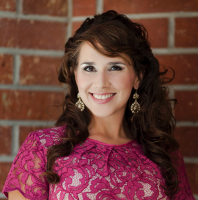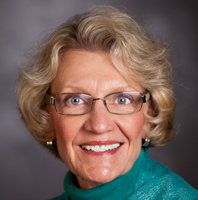You can find most of these resources at online bookstores or in a library. All are useful for teaching worship at the college or seminary level. Many also work well for worship planning teams in congregations.
 Emily Andrews: music and worship instructor; ordained minister in Cooperative Baptist Fellowship
Emily Andrews: music and worship instructor; ordained minister in Cooperative Baptist Fellowship
Samford University: Birmingham, Alabama
Worship courses: Intro to Music and Worship, Intro to Worship Leadership, Colloquium in Church Music, Supervised Ministry, Music and Worship Seminar, Keyboard Harmony
Top short reads for worship:
- Constance M. Cherry, The Worship Architect: A Blueprint for Designing Culturally Relevant and Biblically Faithful Services
- Christopher Ellis, Approaching God: A Guide for Worship Leaders and Worshippers
- Michael Hawn, Gather Into One: Praying and Singing Globally
- Todd E. Johnson, ed., Conviction of Things Not Seen: Worship and Ministry in the 21st Century
- Charlotte Kroeker, ed., Music in Christian Worship: At the Service of the Liturgy
- Mark Labberton, The Dangerous Act of Worship: Living God’s Call to Justice
- Robb Redman, The Great Worship Awakening: Singing a New Song in the Postmodern Church
- Greg Scheer, The Art of Worship: A Musician’s Guide to Leading Modern Worship
- James K. A. Smith, Imagining the Kingdom: How Worship Works
- Susan J. White, Foundations of Christian Worship
Where to find resources for assigned readings: Recommendations from friends, colleagues, worship conferences and professional gatherings. Amazon’s new and popular worship-related book rankings. Calvin Institute of Christian Worship’s “user-friendly search engine, copious resources and expert articles.”
In brief: Four books above are especially helpful for church committees. Christopher Ellis’s Approaching God will help congregants study worship in greater depth. It includes an introductory theology of worship, worship planning guide, pastoral guidance and hands-on exercises in each chapter. Two edited collections, Johnson’s Convictions of Things Not Seen and Kroeker’s Music in Christian Worship, provide diverse content that can be easily read and applied a chapter at a time. Mark Labberton’s work is an accessible and clear call to connect the vertical and horizontal dynamics of public worship. With biblical depth and pastoral wisdom, Labberton firmly relates worship and ethics.
 Barbara Day Miller: associate dean of worship and music; ordained deacon in the United Methodist Church
Barbara Day Miller: associate dean of worship and music; ordained deacon in the United Methodist Church
Candler School of Theology: Emory University, Atlanta, Georgia
Worship courses: Candler Singers (select seminary choir), Christian Year Celebrations, Writing Liturgical Texts
Top short reads for worship:
- Barbara Day Miller, Encounters with the Holy: A Conversational Model for Worship
- Barbara Day Miller, The New Pastor’s Guide for Leading Worship
- Ruth C. Duck, Worship for the Whole People of God
- Greg Scheer, The Art of Worship: a Musician’s Guide to Leading Modern Worship
- Corinne Ware, Discover Your Spiritual Type
- James F. White, A Brief History of Christian Worship
- James F. White, Documents of Christian Worship: Descriptive and Interpretive Sources
Top websites for worship planning:
- Basecamp (web-based project management for worship planning)
- Hymnary (download texts and tunes, learn about hymns and worship songs)
- Revised Common Lectionary (lectionary texts, reproducible art, prayers)
- Sundays and Seasons (and other denominational websites)
- United Methodist Church worship resources (including top CCLI songs for United Methodist congregations)
Where to find resources for assigned readings: Conversations with other professors in the field, conferences, reviews of new books, acquaintance with authors, evaluations by students.
In brief: Candler Singers, a select choir of 20 voices, leads worship in all styles every week. As we rehearse the repertoire, we study hymnody from all periods, do psalm versions from chant to contemporary praise, use service music and sung prayer from a wide range of traditions and denominations, and learn to lead congregational song.
My classes primarily engage the practices of ministry, so denominational hymnals and books of worship are important. Worship planning teams in congregations need to know their own denominational resources. Exploring Corinne Ware’s Spirituality Type Indicator is a fun way for teams to discover why certain worship elements or practices appeal to various spiritual types. Committees can use Jim White’s Documents book to teach congregations—seeing and hearing the “original” prayers and writings is enlightening. Confirmation classes love White’s sections on Christian Initiation and the Eucharist.
 Ruth Duck: professor of worship; hymnist
Ruth Duck: professor of worship; hymnist
Garrett Evangelical Seminary: Chicago, Illinois
Worship courses: Christian Public Worship, Finding Words for Worship, Baptism and Reaffirmation, Liturgies of Anointing and Reconciliation, Congregational Song, Preaching, Worship and the Arts
Top short reads for worship:
- Melva Costen, African American Christian Worship
- Charles E. Farhadian, ed., Christian Worship Worldwide
- Leah Francis Gunning, Ferguson and Faith: Sparking Leadership and Awakening Community
- Kimberly Long, The Worshiping Body
- Maria Mankin and Maren C. Tirabassi, From the Psalms to the Clouds: Connecting to the Digital Age
- Gail Ramshaw, God Beyond Gender
- Clayton J. Schmit, Too Deep for Words: A Theology of Liturgical Expression
- Ralph C. Watkins, Jason A. Barr Jr and Jamal Harrison Bryant, The Gospel Remix: Reaching the Hip Hop Generation
Where to find resources for assigned readings: Catalogues from Westminster John Knox and others, book tables at meetings such as North American Academy of Liturgy and Hymn Society, Calvin Institute of Christian Worship.
In brief: Long’s The Worshiping Body, an excellent guide to worship leadership and how we communicate with our bodies, might be good for lay readers and leaders. Schmit’s Too Deep for Words would be good for worship committees because of its Spirit-filled exploration of vivid and meaningful word choices for preaching and worship.
My own book, Worship for the Whole People of God, discusses the breadth of worship cross-culturally, theologically and practically. Worship committees eager to celebrate diversity and lament violence can read Ramshaw’s thoughtful God Beyond Gender, Costen’s clear and comprehensive African American Christian Worship, Watkins’ The Gospel Remix and Gunning’s Ferguson and Faith, which give good examples of how our religious rituals need not be confined to church buildings.
 Jeremy Perigo: director of music & worship programs; lecturer in worship
Jeremy Perigo: director of music & worship programs; lecturer in worship
London School of Theology: London, United Kingdom
Worship courses: For BA students, Theology of Worship 1 & 2, Worship and Music Ministry, Corporate Worship Lab, Worship Clinic and Language and Worship; for MA students, the Christian Worship module; for MTh and PhD students, supervises those who focus on theology, worship studies and worship practice.
Top short reads for undergraduate worship students:
- Walter Brueggemann, Worship in Ancient Israel: An Essential Guide
- Constance Cherry, The Worship Architect: A Blueprint for Designing Culturally Relevant and Biblically Faithful Services
- Ralph Martin, Worship in the Early Church
- Howard Marshall, Last Supper and Lord’s Supper
- Debra and Ron Rienstra, Worship Words
Where to find resources for assigned readings: Amazon for new worship-related books. The Robert E. Webber Institute for Worship Studies’ “superb annotated bibliography,” updated every six months by Mark Torgerson. Facebook posts and Twitter feeds from scholars such as Monique Ingalls, Lester Ruth and John D. Witvliet.
In brief: Martin’s Worship in the Early Church is an accessible text on worship that would engage congregations that want to better understand worship in the New Testament. The Rienstras’ Worship Words and Cherry’s The Worship Architect are both extremely helpful for worship leaders.
 Ron Rienstra: associate professor of preaching and worship arts; ordained minister in Reformed Church in America
Ron Rienstra: associate professor of preaching and worship arts; ordained minister in Reformed Church in America
Western Theological Seminary: Holland, Michigan
Worship courses: Foundations of Worship, Practice of Preaching & Worship, Worship Words, Contemporary and Emerging Worship, The Church’s Common Chord, Liturgical Shenanigans: Ritual Theory and Christian Formation
Top short reads for worship:
- Ron Anderson, “Form and Freedom: The Discipline of Worship,” Encounter 60.3 (Summer 1999), 271-282.
- Nairobi Statement on Worship and Culture
- New PCUSA Directory for Worship
- Ron Rienstra, Disciples: Worship
- Ron Rienstra, “Good Worship: Articulating Standards of Excellence in Worship without Becoming the Liturgy Police,” Liturgy 29:2 (2014), 52-58.
- Lester Ruth, “Don’t Lose the Trinity! A Plea to Songwriters”
- Jean-Jacques von Allmen, “Theological Frame for Liturgical Renewal,” Church Quarterly 2 (1969-70): 8-23.
- Will Willimon, “The Lord’s Supper: Making It Happen in Your Church,” Reformed Liturgy and Music 19, no. 1 (1985): 12).
- John D. Witvliet, “How Common Worship Forms Us for Our Encounter with Death,” chapter 15 in Worship Seeking Understanding.
- John D. Witvliet, “Beyond Style: Asking Deeper Questions about Worship,” Congregations 27, no. 4 (July/August, 2001): 19–21, 35.
- World Communion of Reformed Churches, “Worshiping the Triune God: Receiving and Sharing Christian Wisdom Across Continents and Centuries”
Where to find resources for assigned readings: Colleagues’ recommendations, “footnotes in books and articles I find worthwhile and trustworthy.”
In brief: Any resource that I use in class would be good for church worship or liturgy committees to use.
 Jane Rogers Vann: professor emerita of Christian education
Jane Rogers Vann: professor emerita of Christian education
Union Presbyterian Seminary: Richmond, Virginia
Worship courses: Worship, Sacraments, and Education (seminary); Worship and Sacraments (for PCUSA Christian Educator Certification program)
Top short reads for worship:
- Daniel T. Benedict Jr, Patterned by Grace: How Liturgy Shapes Us, 11-20, 121-126.
- Ronald P. Byars, “Body Language,” Call to Worship, Vol 35.2, 2001.
- Paul Galbreath, Leading From the Table, 1-17.
- John F. Jansen, “Baptism in the New Testament—Some Perspectives,” Reformed Liturgy and Music, Fall 1981, 164-171.
- Aidan Kavanagh, “A Rite of Passage,” Call to Worship, Vol. 36.2, 2002-2003.
- “Order for the Service for the Lord’s Day,” Service for the Lord’s Day, SLR#1, PCUSA, 1984—OR Book of Common Worship, PCUSA, 34-45.
- Jane Rogers Vann, Worship Matters: A Study for Congregations
- Lawrence Hull Stookey, Let the Whole Church Say “Amen!” especially 11-34.
- Howard Vanderwell, ed., Church for All Ages: Generations Worshiping Together, chapters 4 and 5.
- Wasserman, “The Shape of the Eucharistic Thanksgiving,” Reformed Liturgy and Music, vol. 29, n 3, 1995, 139-145.
- John H. Westerhoff, “Evangelism, Evangelization, and Catechesis,” Call to Worship, 2002-03, 5-14.
Where to find resources for assigned readings: Journals, book reviews and publishers’ catalogs, talking to colleagues about what they are reading.
In brief: My PCUSA Christian Educator Certification students seem excited about course content and eager to integrate what they have learned into their ministries. PCUSA church worship committees will benefit from reading our denomination’s “Order for the Service for the Lord’s Day” or Book of Common Worship, pp. 34-45. Jansen’s “Baptism in the New Testament” article might inspire a Bible study of passages that describe baptism. Wasserman’s “The Shape of the Eucharistic Thanksgiving” unpacks the Trinitarian structure of the Great Prayer of Thanksgiving and shows it’s far more than a long prayer. Stookey’s book will help people lead prayer in public worship.
My favorite quote from Benedict’s Patterned by Grace is: “The three-in-one God is a community of love dancing with such mutual reverence for each other that this love spills over and reaches out to indwell us and to sweep us up into the life of God creating, redeeming, and sustaining the beloved….Here we have come to the heart of liturgical prayer: we find ourselves dancing with God!”
Tom Schwanda: associate professor of Christian formation and worship; minister ordained in Reformed Church in America
Wheaton College: Wheaton, Illinois
Worship courses: Worship and Spirituality, Origins of Christian Worship, History of Christian Spirituality, Spiritual Theology (with sessions on sacraments and on using Psalms for lament)
Top short reads for worship:
- Paul Bradshaw, Early Christian Worship
- Christopher Hall, Worshiping with the Church Fathers
- Leanne Van Dyk, A More Profound Alleluia
- Leonard J. Vander Zee, Christ, Baptism and the Lord’s Supper
- Robert E. Webber, Ancient-Future Time: Forming Spirituality through the Christian Year
Top short reads for church worship committees:
- Debra Rienstra, “Shaping Our Soul Together: Worship” in Rienstra, So Much More: An Invitation to Christian Spirituality
- Tom Schwanda, “Improving Our Baptism: How can we better claim and celebrate our baptism?” RW 34 (December 1994).
- Paul J. Wadel, “Worshiping Dangerously: The Risky Business of Becoming Friends of God” chapter in Wadel, Becoming Friends: Worship, Justice and the Christian Practice of Friendship
- John D. Witvliet, “Soul Food for the People of God”, chapter 10 in Witvliet, Worship Seeking Understanding
- John D. Witvliet, “A Time to Weep: Liturgical lament in times of crisis,” Reformed Journal 44 (June 1997). “A Time to Weep—During Advent,” RW 45 (September 1997); “A Time to Weep—on Good Friday,” RW 46 (December 1997).
Where to find resources for assigned readings: Discussion with other worship professors, following the release of new books, Amazon.
In brief: I use at least one hymn or song every class period in Spiritual Theology to illustrate or reinforce some theological doctrine or perspective. In my History of Christian Spirituality course, I also examine the appropriate worship themes of scripture reading, preaching, singing, sacraments and prayer for each of the various persons studied.


